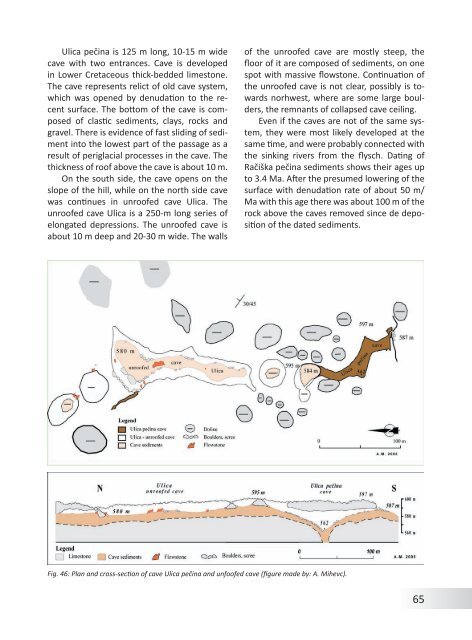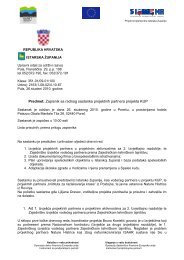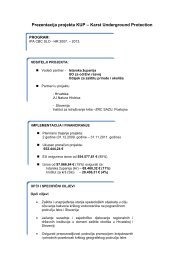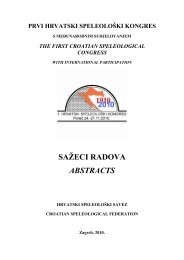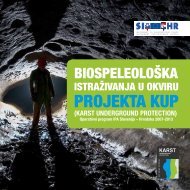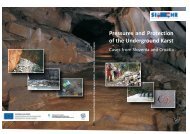Case Studies from the Dinaric Karst of Slovenia
Case Studies from the Dinaric Karst of Slovenia
Case Studies from the Dinaric Karst of Slovenia
Create successful ePaper yourself
Turn your PDF publications into a flip-book with our unique Google optimized e-Paper software.
Ulica pečina is 125 m long, 10-15 m widecave with two entrances. Cave is developedin Lower Cretaceous thick-bedded limestone.The cave represents relict <strong>of</strong> old cave system,which was opened by denudation to <strong>the</strong> recentsurface. The bottom <strong>of</strong> <strong>the</strong> cave is composed<strong>of</strong> clastic sediments, clays, rocks andgravel. There is evidence <strong>of</strong> fast sliding <strong>of</strong> sedimentinto <strong>the</strong> lowest part <strong>of</strong> <strong>the</strong> passage as aresult <strong>of</strong> periglacial processes in <strong>the</strong> cave. Thethickness <strong>of</strong> ro<strong>of</strong> above <strong>the</strong> cave is about 10 m.On <strong>the</strong> south side, <strong>the</strong> cave opens on <strong>the</strong>slope <strong>of</strong> <strong>the</strong> hill, while on <strong>the</strong> north side cavewas continues in unro<strong>of</strong>ed cave Ulica. Theunro<strong>of</strong>ed cave Ulica is a 250-m long series <strong>of</strong>elongated depressions. The unro<strong>of</strong>ed cave isabout 10 m deep and 20-30 m wide. The walls<strong>of</strong> <strong>the</strong> unro<strong>of</strong>ed cave are mostly steep, <strong>the</strong>floor <strong>of</strong> it are composed <strong>of</strong> sediments, on onespot with massive flowstone. Continuation <strong>of</strong><strong>the</strong> unro<strong>of</strong>ed cave is not clear, possibly is towardsnorhwest, where are some large boulders,<strong>the</strong> remnants <strong>of</strong> collapsed cave ceiling.Even if <strong>the</strong> caves are not <strong>of</strong> <strong>the</strong> same system,<strong>the</strong>y were most likely developed at <strong>the</strong>same time, and were probably connected with<strong>the</strong> sinking rivers <strong>from</strong> <strong>the</strong> flysch. Dating <strong>of</strong>Račiška pečina sediments shows <strong>the</strong>ir ages upto 3.4 Ma. After <strong>the</strong> presumed lowering <strong>of</strong> <strong>the</strong>surface with denudation rate <strong>of</strong> about 50 m/Ma with this age <strong>the</strong>re was about 100 m <strong>of</strong> <strong>the</strong>rock above <strong>the</strong> caves removed since de deposition<strong>of</strong> <strong>the</strong> dated sediments.Fig. 46: Plan and cross-section <strong>of</strong> cave Ulica pečina and unfo<strong>of</strong>ed cave (figure made by: A. Mihevc).65


